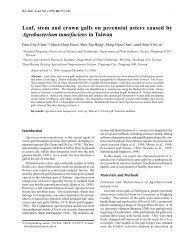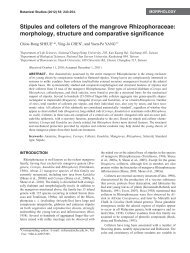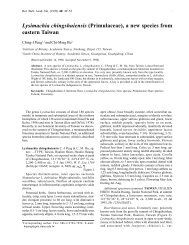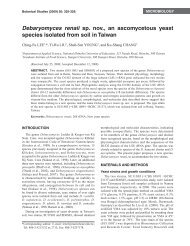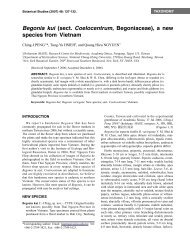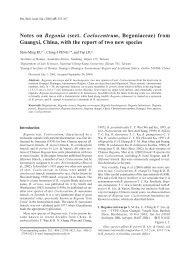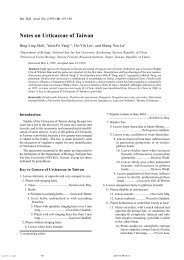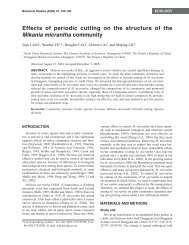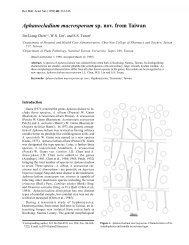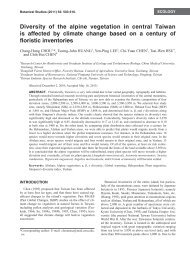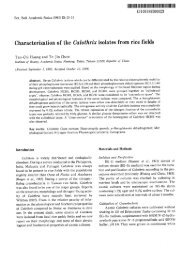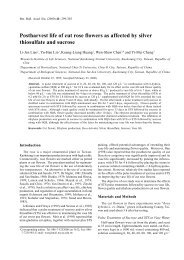Colocasia lihengiae (Araceae: Colocasieae), a ... - Academia Sinica
Colocasia lihengiae (Araceae: Colocasieae), a ... - Academia Sinica
Colocasia lihengiae (Araceae: Colocasieae), a ... - Academia Sinica
Create successful ePaper yourself
Turn your PDF publications into a flip-book with our unique Google optimized e-Paper software.
Long Bot. Bull. and Acad. Liu — Sin. A new (2001) species 42: 313-317 of <strong>Colocasia</strong> from China 313<br />
<strong>Colocasia</strong> <strong>lihengiae</strong> (<strong>Araceae</strong>: <strong>Colocasieae</strong>), a new species from<br />
Yunnan, China<br />
Chun-Lin Long 1, * and Ke-Ming Liu 2<br />
1Kunming Institute of Botany, Chinese Academy of Sciences, Heilongtan, Kunming 650204, Yunnan, China<br />
2Department of Botany, College of Life Science, Hunan Normal University, Changsha 410081, China<br />
(Received May 9, 2000; Accepted October 2, 2000)<br />
Abstract. A new species of <strong>Colocasia</strong> Schott, C. <strong>lihengiae</strong> C. L. Long et K. M. Liu, sp. nov., is described and<br />
illustrated. The species is restricted to the rainforest of Xishuangbanna in southern Yunnan, China. Diagnostic morphological<br />
characters that distinguish the new species from the related species, C. fallax Schott, are discussed. Chromosome<br />
numbers (2n=28) were observed in plants of C. <strong>lihengiae</strong> cultivated at the Kunming Botanical Garden.<br />
Keywords: <strong>Araceae</strong>; China; <strong>Colocasia</strong> <strong>lihengiae</strong>; New species; Taxonomy; Xishuangbanna; Yunnan.<br />
Introduction<br />
Yunnan, a province in southwest China with an area of<br />
394,000 km 2 , is notable for its rich plant diversity. Over<br />
15,000 vascular plants have been recorded from Yunnan.<br />
Since the 1830s more than 2,100 new species of vascular<br />
plants have been described from Yunnan and collected by<br />
botanists such as J. Anderson, J. M. Delavay, Prince Henri<br />
d’Orleans, A. Henry, E. H. Wilson, G. Forrest, E. E. Maire,<br />
F. Kingdon-Ward, H. Handel-Mazzetti, K. A. H. Smith, J.<br />
F. Rock, T. T. Yü, R. C. Ching, C. W. Wang, C. Wang, K.<br />
M. Feng and other Chinese botanists (Bao et al., 1998).<br />
Today, Yunnan is still one of the most interesting places<br />
for botanical exploration.<br />
<strong>Colocasia</strong> (<strong>Araceae</strong>) is a tropical Asian genus. Until<br />
1997, only about nine species had been described (Engler<br />
and Krause, 1920; Li, 1979; Sivadasan, 1982; Plucknett,<br />
1983; Shaw, 1984; Sreekumari and Mathew, 1991a, b; Li and<br />
Wei, 1993; Hay, 1996; Mayo et al., 1997). In 1999, an additional<br />
species, <strong>Colocasia</strong> gaoligongensis, was described<br />
by Li and Long from a small area in western Yunnan, close<br />
to northern Myanmar (Burma).<br />
In June 1998, we collected an aroid in a dense rainforest<br />
in valleys of southern Yunnan. This perennial herb with<br />
long stolons and large leaf blades, and with inflorescences<br />
lacking an appendix, was difficult to determine as belonging<br />
to Remusatia, <strong>Colocasia</strong> or Alocasia. Living plants<br />
and herbarium specimens were collected and brought to<br />
the Kunming Botanical Garden for cultivation. Further<br />
study of the morphology, especially of the ovules, revealed<br />
the plant to be a new species of <strong>Colocasia</strong>.<br />
*Corresponding author. Tel: (0086) 871-522-3233; Fax: (0086)<br />
871-515-0227; E-mail: long@mail.kib.ac.cn, or chunlinlong@<br />
hotmail.com<br />
Materials and Methods<br />
Three living plants were brought to Kunming. Before<br />
planting them in the greenhouse of the Kunming Botanical<br />
Garden at the Kunming Institute of Botany, most of<br />
the leaves were removed to reduce stress. The largest<br />
plant was grown in open ground; the other two were<br />
grown in pots.<br />
Herbarium specimens were prepared from both field and<br />
greenhouse plants. They were deposited in the Herbarium<br />
of Kunming Institute of Botany (KUN). Both female and<br />
male flowers were observed under a microscope.<br />
Root tips were collected for chromosome observations.<br />
The growing root tips were pretreated with 0.002 M 8hydroxiquinoline<br />
for 2 h at room temperature (20 ± 2°C)<br />
and for an additional 2 h in a refrigerator (8 ± 2°C). They<br />
were subsequently fixed in ethanol-acetic acid (3:1) and<br />
kept in a refrigerator until observed. The fixed root tips<br />
were rinsed in water and hydrolyzed in a 1N hydrochloric<br />
acid at 60°C for 5 min. After washing in distilled water and<br />
removing the excess, the samples were submerged in Feulgen<br />
stain for 30 min, transferred into aceto-carmin and 45%<br />
acetic acid for 10 min, and squashed in 45% acetic acid.<br />
The chromosomes were then examined under a microscope<br />
(Nguyen, 1998).<br />
Additional specimens similar to the new species were<br />
examined and recorded. In total, 16 herbarium specimens<br />
(ca. 80 individuals) of <strong>Colocasia</strong> were studied. These<br />
specimens are deposited in A/GH, CAS, HAST, HITBC,<br />
KUN, MO, NY, and PE.<br />
Description<br />
<strong>Colocasia</strong> <strong>lihengiae</strong> C. L. Long et K. M. Liu, sp. nov.—<br />
TYPE: CHINA. Yunnan Prov.: Mengla, Mengxing River
314 Botanical Bulletin of <strong>Academia</strong> <strong>Sinica</strong>, Vol. 42, 2001<br />
Figure 1. Illustration of <strong>Colocasia</strong> <strong>lihengiae</strong> C. L. Long et K. M. Liu, sp. nov. (drawn by Yitao Liu). a, flowering plant; b,<br />
inflorescence; c, synandrium; d, female flower; e, transverse section of ovary; f, enlargement of an ovule; g, spadix.
Long and Liu — A new species of <strong>Colocasia</strong> from China 315<br />
watershed, in a valley with dense rainforest, 20 Jun 1998,<br />
Long Chun-lin & Li Meilan 9806 (holotype: KUN);<br />
Paratype: 18 Jul 1998, Long Chun-lin & Li Meilan 9824<br />
(KUN), cultivated in Kunming Botanical Garden.<br />
Figure 1<br />
<strong>Colocasia</strong> fallax Schott similis, sed appendice absenti<br />
differt.<br />
Terrestrial perennial herbs with stolons (stoloniferous<br />
runners) and an erect rhizome. Rhizome 4-8 cm long, 2-3<br />
cm in diam.; stolons (stoloniferous runners) 6-12, trailing<br />
horizontally, non-branching, thin, pale green or pale purple,<br />
70-80 cm long, 0.5 cm in diam., with dark green cataphylls;<br />
internodes cylindric, 15-25 cm long, without tubercles.<br />
Leaves 4-6; petiole cylindric, light green, reddish-purple,<br />
80-120 cm long; blade peltate, sagittate-cordate,<br />
membranaceous, 30-40 cm long, 18-25 cm wide, upper surface<br />
glossy green, lower surface pale green; primary lateral<br />
veins 6 pairs, pale green; marginal vein inconspicuous.<br />
Inflorescences (4-) 5 (-6); peduncle cylindrical, pale green,<br />
40-50 cm long, much shorter than petiole. Spathe constricted<br />
in the middle, lower convolute part (tube) yellowish<br />
green, 4-5 cm long, 2 cm in diam., nearly cylindrical;<br />
lamina oblong-lanceolate, golden yellow, 11-13 cm long, 4<br />
cm wide, patent to reflexed. Spadix fragrant, female zone<br />
golden yellow, cylindrical, 2-2.5 cm long, 0.7 cm in diam.,<br />
half as short as spadix; male zone cylindrical, yellow, 3.5<br />
cm long, 0.6-0.8 cm in diam.; neutral flower zone between<br />
female and male zones, cylindrical, 1 cm long, 0.4-0.5 cm<br />
in diam.; appendix absent; female flower obovoid, carpels<br />
3 or 4, ovary unilocular, placentae 2, parietal, ovules<br />
spindle shaped, nearly erect, numerous, stigma sessile,<br />
discoid; synandria 8-10-androus, ca. 0.1 cm long, yellow.<br />
Fruits not seen. Chromosome number: 2n = 28.<br />
This species is gratefully dedicated to our advisor, Prof.<br />
Li Heng, who has contributed much to the study of<br />
<strong>Araceae</strong> in China. Her wide knowledge of <strong>Araceae</strong> and<br />
other monocots and her contribution to Chinese botany<br />
Table 1. Comparison of <strong>Colocasia</strong> <strong>lihengiae</strong> and C. fallax.<br />
are of great importance for a better understanding of<br />
aroids and of the flora of Yunnan.<br />
Phenology<br />
In the wild, flowering occurs between June and August;<br />
fruiting occurs between July and October. In the botanical<br />
garden, flowering occurs between July and October;<br />
fruiting occurs between August and late October. Pollinators<br />
were seen both in the field and in cultivated plants.<br />
These insects are small flies, probably members of the genus<br />
Colocasiomyia (H. Wang, pers. com.).<br />
Distribution and Habitat<br />
<strong>Colocasia</strong> <strong>lihengiae</strong> grows in clusters of 1-4 individuals<br />
in small populations at edges of and in forests in limestone<br />
areas at 600 m. Other aroids in the same habitats<br />
include Alocasia odora Koch, A. navicularis (C. Koch)<br />
C. Koch, A. longiloba Miq., <strong>Colocasia</strong> gigantea (Bl.)<br />
Hook. f., C. esculenta (L.) Schott, Pothos scandens L.,<br />
Remusatia vivipara (Roxb.) Schott, and Rhaphidophora<br />
decursiva (Roxb.) Schott.<br />
Discussion<br />
Characters <strong>Colocasia</strong> <strong>lihengiae</strong> <strong>Colocasia</strong> fallax<br />
<strong>Colocasia</strong> <strong>lihengiae</strong> is an attractive evergreen perennial<br />
herb with handsome foliage and fragrant<br />
inflorescences.<br />
After a thorough search through the literature (Hook.<br />
f., 1893; Li, 1979; Li and Wei, 1993; Yoshino, 1994; Mayo<br />
et al., 1997; Nguyen, 1998; Li and Long, 1998, 1999), the<br />
closest species to our material appears to be <strong>Colocasia</strong><br />
fallax Schott. But <strong>Colocasia</strong> <strong>lihengiae</strong> is clearly different<br />
from C. fallax. The most obvious difference is the absence<br />
of an appendix in spadix of C. <strong>lihengiae</strong>. The differences<br />
and similarities between these two species are shown in<br />
Table 1.<br />
Growth habit In small clusters Massive<br />
Rhizome Erect, 4-8 cm long, 2-3 cm diam. Horizontal, 4-5 cm long, 0.8-1.5 cm diam.<br />
Tubercles None Small, 1-1.5 cm diam.<br />
Stolon 6-12, each 70-80 cm long None<br />
Petiole 80-120 cm long 30-50 cm long<br />
Blade Sagittate-cordate, 30-40 cm long and 18-25 cm wide Ovate-cordate, 8-15 cm long and 5-12 cm wide<br />
Primary lateral vein 6 pairs 3-5 pairs<br />
Peduncle 40-50 cm long 7-15 cm long<br />
Spathe tube Ovate-oblong, 4-5 cm long, 2 cm diam. Oblong, 2.3 cm long, 1.2 cm diam.<br />
Spathe lamina Oblong-lanceolate, 11-13 cm long, 4 cm wide, reflexed Oblong, 4-6.5 cm long, 2 cm wide, reflexed<br />
Male zone 1.3-1.8 cm long, 0.4 cm diam. 3.5 cm long, 0.6-0.8 cm diam.<br />
Female zone 2-2.5 cm long, 0.7 cm diam. 1.5 cm long, 0.5 cm diam.<br />
Sterile zone 1 cm long, 0.4-0.5 cm diam. 1 cm long, 0.1-0.2 cm diam.<br />
Appendix None Fusiform, 3 cm long, 0.2-0.3 cm diam.<br />
Male flower Synandria 8-10-androus Synandria 6-8-androus<br />
Female flower Ovary ovoid, placentae 2 Ovary ovoid, placentae 2<br />
Habitat Valleys near or in rainforest, alt. 600 m Valleys in forests or scrubs, alt. 850-1,400 m<br />
Distribution Endemic to Xishuangbanna, China China (S Yunnan), N Bangladesh, NE India, Thailand
316 Botanical Bulletin of <strong>Academia</strong> <strong>Sinica</strong>, Vol. 42, 2001<br />
The new species is also similar to some species of<br />
Alocasia (e.g. Alocasia odora and A. longiloba). It differs<br />
from these by its long stoloniferous runners, many<br />
ovules per ovary, and lack of an appendix in spadix. It is<br />
notable that the present new species possesses characteristics<br />
not only of <strong>Colocasia</strong> but also of Alocasia and<br />
Remusatia, which may be a result of natural hybridization.<br />
Natural hybridization between <strong>Colocasia</strong> and Alocasia<br />
has been suggested and described. Yoshino (1994, 1995,<br />
1998) succeeded in crossing <strong>Colocasia</strong> esculenta var.<br />
aquatilis and Alocaisa brisbanensis. Possible hybrids<br />
within <strong>Colocasia</strong> may occur in nature. Meiotic chromosome<br />
behavior in hybrids between <strong>Colocasia</strong> esculenta<br />
and C. gigantea have been reported (Okada and Hambali,<br />
1989; Yoshino, pers. com., 1999). Based on the morphological<br />
characters of <strong>Colocasia</strong> <strong>lihengiae</strong>, determining its<br />
phylogenetic position is difficult. Molecular approaches<br />
and artificial hybridizations may reveal phylogenetic relationships<br />
between it and other taxa of <strong>Colocasia</strong>, Alocasia<br />
and Remusatia.<br />
Acknowledgements. The field study was supported by the<br />
Chinese Academy of Sciences (KZ951-A1-104), the Natural Science<br />
Foundation of China (30170102) and the Natural Science<br />
Foundation of Yunnan Province (2001C0058M). Peter Boyce<br />
of the Royal Botanic Gardens, Kew helped us edit and modify<br />
the manuscript and gave useful comments. Li Meilan, Wang<br />
Hong and Yang Shixiong participated in the field trip. Zhou<br />
Qixing assisted in checking chromosome numbers. Luo Jifeng<br />
and Zhou Yilan maintained the plants in the Kunming Botanical<br />
Garden. Philip Thomas of the Royal Botanic Gardens, Edinburgh<br />
critically read the original manuscript. The authors are grateful<br />
to all of them.<br />
Literature Cited<br />
Bao, S.Y., P.Y. Mao, and S.X. Yuan. 1998. A brief history of<br />
plant collection in Yunnan (1919-1950). China Science &<br />
Technology Press, Beijing.<br />
Engler, A. and K. Krause. 1920. Additamentum ad Araceas-<br />
Philodendroideas, <strong>Araceae</strong>-Colocasioideae. In A. Engler<br />
(ed.), Das Pflanzenreich 71(IV. 23E), pp. 3-132.<br />
Hay, A. 1996. A new Bornean species of <strong>Colocasia</strong> Schott<br />
(<strong>Araceae</strong>: <strong>Colocasieae</strong>), with a synopsis of the genus in<br />
Malesia and Australia. Sandakania 7: 31-48.<br />
Hook, f. 1893. Flora of British India, vol. 6. L. Reeve & Co,<br />
London, 524 pp.<br />
Li, H. 1979. <strong>Araceae</strong>. In C.Y. Wu and H. Li (eds.), Fl. Reip.<br />
Pop. Sin. Vol. 31(2), Science Press, Beijing, pp. 67-74.<br />
Li, H. and Z.X. Wei. 1993. <strong>Colocasia</strong> heterochroma, a new species<br />
of <strong>Colocasia</strong> from <strong>Araceae</strong>. Acta Bot. Yunnanica 15<br />
(1): 16-17.<br />
Li, H. and C.L. Long. 1998. A preliminary revision of <strong>Araceae</strong><br />
of China. Acta Bot. Yunnanica (suppl. 10): 12-23.<br />
Li, H. and C.L. Long. 1999. A new species of <strong>Colocasia</strong><br />
(<strong>Araceae</strong>) from Mts. Gaoligong, China. Feddes Repert. 110<br />
(1999) 5-6: 423-424.<br />
Mayo, S.J., J. Bogner, and P.C. Boyce. 1997. The Genera of<br />
<strong>Araceae</strong>. The Royal Botanic Gardens, Kew, pp. 280-283.<br />
Nguyen, V.X. 1998. Isozyme Variation and Phylogenetic Relationships<br />
in Taro, <strong>Colocasia</strong> esculenta Schott, and related<br />
taxa. Unpublished Ph. D. Thesis, The Okayama University,<br />
Japan.<br />
Okada, H. and G.G. Hambali. 1989. Chromosome behaviors in<br />
meiosis of the interspecific hybrids between <strong>Colocasia</strong><br />
esculenta (L.) Schott and C. gigantea Hook. f. Cytologia<br />
54: 389-393.<br />
Plucknett, D.L. 1983. Taxonomy of the genus <strong>Colocasia</strong>. In J.<br />
K. Wang (ed.), Taro: a Review of <strong>Colocasia</strong> esculenta and<br />
its Potentials. University of Hawaii Press, Honolulu.<br />
Shaw, D.E. 1984. Ovary data, seed and germination in taro from<br />
two sites in Queensland, Australia. In S. Chandra (ed.), Edible<br />
Aroids. Clarendon Press, Oxford.<br />
Sivadasan, M. 1982. Taxonomic study of <strong>Araceae</strong> of south India.<br />
Unpublished Ph. D. Thesis, University of Calicut, India.<br />
Sreekumari, M.T. and P.M. Mathew. 1991a. Karyomorphology<br />
of five morphotypes of taro, <strong>Colocasia</strong> esculenta (L.)<br />
Schott. Cytologia 56: 215-218.<br />
Sreekumari, M.T. and P.M. Mathew. 1991b. Karyotypically<br />
distinct morphotypes of taro, <strong>Colocasia</strong> esculenta (L.)<br />
Schott. Cytologia 56: 399-402.<br />
Yoshino, H. 1994. Studies on the Phylogenetic Differentiation<br />
in Taro, <strong>Colocasia</strong> esculenta Schott. Unpublished Ph. D.<br />
Thesis, Kyoto University, Japan.<br />
Yoshino, H. 1995. Some species of genus <strong>Colocasia</strong> having chloroplast<br />
DNA of Alocasia macrorrhiza var. variegata. In<br />
H. Li (ed.), Proceedings of the VI International Aroid<br />
Conference. Editorial Department of Acta Botanica<br />
Yunnanica, Kunming.<br />
Yoshino, H., T. Ochiai, and M. Tahara. 1998. An artificial inter-generic<br />
hybrid between <strong>Colocasia</strong> esculenta (L.) Schott<br />
and Alocasia macrorrhiza G. Don. In Proceeding of the<br />
Monocots II and Grass III, Sydney (in press).
Long and Liu — A new species of <strong>Colocasia</strong> from China 317<br />
Liu)<br />
<strong>Colocasia</strong> fallax Schott<br />
2n=28<br />
<strong>Araceae</strong> <strong>Colocasia</strong> <strong>lihengiae</strong> C. L. Long & K. M.



